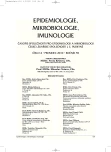-
Medical journals
- Career
Sporicidal Agents Highly Effective in Inactivating Bacillus anthracis Spores
Authors: J. Severa 1; Vl. Klaban 1; T. Černý 2; I. Bernadiová 2; J. Cabal 3
Authors‘ workplace: Decomkov Praha, s. r. o. 1; Státní veterinární ústav Praha 2; Univerzita obrany, Fakulta vojenského zdravotnictví, katedra toxikologie Hradec Králové 3
Published in: Epidemiol. Mikrobiol. Imunol. 59, 2010, č. 4, s. 205-208
Overview
By the dilution-neutralization test – a quantitative suspension test without organic load – the biocidal products Hvězda and PTSPCH-J have been shown highly effective in inactivating Bacillus anthracis spores.
Key words:
anthrax – spores – Bacillus anthracis – inactivation.
Sources
1. Armon, R., Weltch-Cohen, G., Bettane, P. Disinfection of Bacillus spp. spores in drinking water by TiO2 photocatalysis as a model for Bacillus anthracis. Supply, 2004, 4, 2, p. 7–14.
2. Cléry-Barraud, C., Gaubert, A., Masson, P., Vidal, D. Combined Effects of High Hydrostatic Pressure and Temperature for Inactivation of Bacillus anthracis Spores. Appl. Environ. Microbiol., 2004, 70, 1, p. 635–637.
3. Blatchley, E. R., Meeusen, A., Aronson, A. I., Brewster, L. Inactivation of Bacillus Spores by Ultraviolet or Gamma Radiation. Environ. Eng., 2005, 131, 9, p. 1245–1252.
4. Česká technická norma ČSN EN 13704 Chemické dezinfekční přípravky – Kvantitativní zkouška s použitím suspenze ke stanovení sporicidního účinku chemických dezinfekčních přípravků používaných pro potraviny, průmysl, domácnosti a veřejné prostory – Zkušební metoda a požadavky (fáze 2/stupeň 1). Český normalizační institut, 2002, 34 s.
5. Hilgren, J., Swanson, K. M. J., Diez-Gonzalez, F., Cords, B. Inactivation of Bacillus anthracis Spores by Liquid Biocides in the Presence of Food Residue. Appl. Environ. Microbiol., 2007, 73, 20, p. 6370–6377.
6. Inglesby, T. V., O Toole, T., Henderson, D. A.,Bartlet, J. G. et al. Antrax as a Biological Weapons. Updated Recomendations for Management. JAMA, 2002, 287, 17, p. 2236–2252.
7. Pohanka, M., Skládal, P. Bacillus anthracis, Francisella tularensis and Yersinia pestis the Most Important Bacterial Warfare Agents – review. Folia Microbiol., 2009, 54, 4, p. 263–272.
8. Rogers, J. V., Choi, Y. W., Richter, W. R., Rudnicki, D. C. et al. Formaldehyde gas nactivation of Bacillus anthracis, Bacillus subtilis, and Geobacillus stearothermophilus spores on indoor surface materials. J. Appl. Microbiol., 2008, 74, 4, p. 1104–1112.
9. Rose, L. J., Rice, E. W., Jensen, B., Murga, R. et al. Chlorine Inactivation of Bacterial Bioterrorism Agents. J. Appl. Microbiol., 2005, 71, 1, p. 566–568.
10. Severa, J., Cabal, J., Hartmanová, M. Pěny jako nosiče látek s dezinfekčním účinkem. Epidemiol. Mikrobiol. Imunol., 2005, 54, p. 161–165.
11. Wallenfels, J., Bencko, V. Bioterorismus, od antraxu až po prostředky hromadného ničení. Prakt. Lék., 2002, 82, 9, s. 516–521.
12. Xu, Sa., Labuza, T., Diez-Gonzales, F. Inactivation Kinetics of Avirulent Bacillus anthracis Spores in Milk with a Combination of Heat and Hydrogen Peroxide. J. Food Protect, 2008, 71, 2, p. 333–338.
Labels
Hygiene and epidemiology Medical virology Clinical microbiology
Article was published inEpidemiology, Microbiology, Immunology

2010 Issue 4-
All articles in this issue
- Leptospirosis in the Czech Republic and Potential for Laboratory Diagnosis
- Antibodies against the Causative Agents of Some Natural Focal Infections in Blood Donor Sera from Western Slovakia
- Surveillance of invasive meningococcal disease and recommended vaccination against meningococcal infections in the Czech Republic
- Colistin in the treatment of severely burned patients infected by multiresistant strains of Pseudomonas aeruginosa
- Sequence characterization of Haemophilus influenzae isolates in the Czech Republic in 2001–2009
- Lipophilic Yeasts of the Genus Malassezia and Skin Diseases.II. Atopic Dermatitis
- Sporicidal Agents Highly Effective in Inactivating Bacillus anthracis Spores
- Epidemiology, Microbiology, Immunology
- Journal archive
- Current issue
- Online only
- About the journal
Most read in this issue- Leptospirosis in the Czech Republic and Potential for Laboratory Diagnosis
- Colistin in the treatment of severely burned patients infected by multiresistant strains of Pseudomonas aeruginosa
- Lipophilic Yeasts of the Genus Malassezia and Skin Diseases.II. Atopic Dermatitis
- Sporicidal Agents Highly Effective in Inactivating Bacillus anthracis Spores
Login#ADS_BOTTOM_SCRIPTS#Forgotten passwordEnter the email address that you registered with. We will send you instructions on how to set a new password.
- Career

